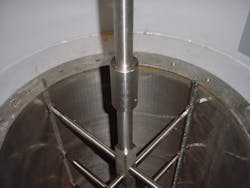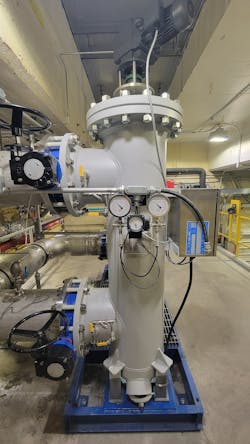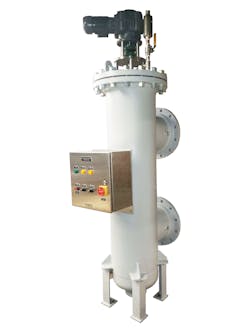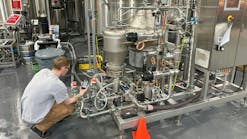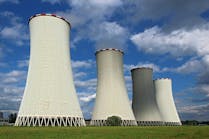Along the coasts and in many countries, seawater is widely used for cooling systems at power plants, as well as for some mining and industrial processes. The challenge, however, is that strainers must sufficiently filter out both small particles (sand, silt, suspended solids) and larger detritus (seaweed, aquatic life, marine debris) to reduce the risk of fouled processes and production downtime. In addition, the strainers must be designed to resist corrosive seawater. Fortunately, advanced strainer design and alternative materials of construction can dramatically reduce fouling and corrosion while cutting costs.
In power plants, once steam passes through a turbine, it must be cooled and returned to the water state before it can be reused to produce more electricity. For this type of application, once-through systems take in water from the ocean, circulate it through pipes to absorb heat from the steam in condenser systems, and discharge the seawater back to the ocean. Once-through systems are popular due to their simplicity and low cost as well as the abundant supply of seawater.
To utilize seawater for cooling, however, strainers are required to filter out a range of material from raw ocean water that could lead to blockage, excessive maintenance and production downtime. The central problem is that most available strainers do not filter out seawater debris at both ends of the size spectrum: from very fine to quite large. While multiple strainers can be used in sequence to filter out a range of debris sizes, this requires extra capital, equipment, space and labor. The corrosiveness of seawater compounds the difficulty of maintaining strainer and process cooling equipment.
“If a facility draws raw water from any natural source for process cooling, it must be sufficiently strained, but manual cleaning can become excessive if bigger debris must regularly be removed,” said Keith Williams, PE, president of Lenexa, Kansas-based Associated Equipment Sales, which represents North American manufacturers of heating, cooling, and hydronic equipment.
In response, the industry has developed automatic self-cleaning scrapers that filter out both tiny particles and large debris. This virtually eliminates manual maintenance as well as equipment clogging and fouling issues downstream, which helps to minimize production downtime.
“For [power] plants using process cooling water from natural sources, I often recommend utilizing an automatic scraper strainer from Acme Engineering that is designed to remove particles down to the micron level while still allowing you to pass surprisingly large debris. I’ve found that this is usually not possible with traditional equipment,” Williams said.
The automatic scraper strainer from Acme Engineering, a North American manufacturer of industrial self-cleaning strainers, is a motorized unit designed to continually remove both very large and very small, suspended solids from cooling water. Cleaning is accomplished by a spring-loaded blade and brush system, managed by a fully automatic control system.
Four scraper brushes rotate at 8 RPM, resulting in a cleaning rate of 32 strokes per minute. The scraper brushes get into wedge-wire slots and dislodge resistant particulates and solids. This approach enables the scraper strainers to resist clogging and fouling when faced with large solids and high solids concentration. It ensures a complete cleaning and is very effective against organic matter “biofouling.”
Blowdown occurs only at the end of the intermittent scraping cycle when a valve is opened for a few seconds to remove solids from the collector area. Liquid loss is well below 1% of total flow.
According to Williams, the scraper basket also allows the strainer to bypass extremely large particles and debris automatically. “In my experience, very few manufacturers can pass such large particles while removing such fine particles,” Williams said.
“Unlike a manual strainer, you do not have to open and clean it. No one has to manually blow down solids. Since it is automatic, it is essentially a set and forget type of system that lets you walk away and focus on other aspects of your facility,” he adds.
He points out the ultimate benefit of utilizing an effective automatic strainer.
“Using an automatic strainer minimizes the required maintenance to keep it operational and helps to maximize production uptime. The larger the facility, the greater the benefit,” Williams said.
Of course, seawater can be highly corrosive to the strainers used to protect power plant process cooling equipment. Typical strainers constructed of carbon steel or even stainless steel quickly deteriorate when exposed to salty, corrosive seawater for extended periods. For this reason, costly duplex stainless steel (with chromium content up to 22%) and super duplex stainless steel (with chromium content up to 25%) are often utilized for greater corrosion resistance. However, even with the added expense, virtually continuous exposure to seawater can still lead to corrosion issues.
As a much more cost-effective alternative, Acme offers the option of using exceptionally corrosion resistant Fiber-Reinforced Plastic (FRP) for external strainer construction, including the pressure vessel itself. The internal mechanism is still manufactured with super duplex or similar steels.
FRP is a composite material made up of polymer supported with fibers for added strength. FRP is already widely utilized for the power plant piping used to carry seawater for once-through process cooling. Due to the FRP’s strength, the material can also be used to build to ASME BPVC Section X standards, which establishes requirements for the fabrication of fiber‐reinforced plastic pressure vessels. Acme has already utilized FRP for pressure vessel applications up to 300 PSI.
The industry can save approximately half the cost or more when the strainer’s seawater intake vessels and piping for process cooling are built with FRP, and only the internals are constructed with super duplex.
Since FRP is far more corrosion resistant to seawater than carbon steel or stainless steel, yet costs just a fraction of expensive duplex or super duplex stainless steels used to resist corrosion, it is becoming a popular construction material for power plant strainer and process cooling equipment.
Although coastal power plants have long used ocean water for cooling, maintaining strainers has been challenging due to the size range of particles and debris that must be filtered out, as well as the corrosive effect of seawater. Using automated scraper strainers along with FRP construction can cost-effectively help to improve both equipment longevity and production.
Del Williams is a technical writer based in Torrance, California. He writes about health, business, technology, and educational issues, and has an M.A. in English from C.S.U. Dominguez Hills.

